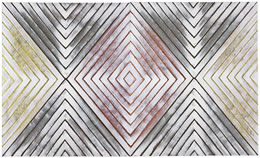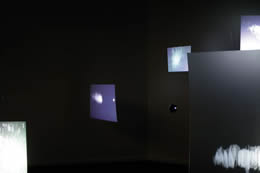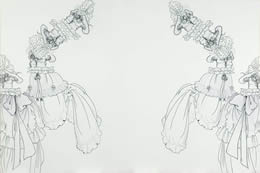-

Number twelve
Gordon Bennett
Australia QLD b.1955
Number twelve 2007
Synthetic polymer paint on linen
The James C Sourris, AM, Collection. Gift of James C Sourris through the Queensland Art Gallery Foundation 2010. Donated through the Australian Government's Cultural Gifts Program
The acknowledged source of Gordon Bennett's Number twelve is American artist Frank Stella's so-called 'Black Paintings' of the late 1950s to early 1960s. They were much admired, not least for problematical titles invoking Nazi history and the Holocaust. Here, Bennett is interested in the 'blackness' of Stella's title.
Number twelve is painted in the traditional Aboriginal palette of red and yellow ochres, and white and black from pipe clay and charcoal. However, Bennett's versions of these colours are metallic with a quasi-spiritual 'shimmer' borrowed from modern painting technology. Bennett is calling into question the authority of both the Kantian ideal of the universal import of Western Abstractionism and the 'unchanging' character of Aboriginal design.
-

Rapt
Justine Cooper
Australia/United States NSW b.1968
Rapt 1998
Videotape transferred to DVD, colour, stereo, 5 minutes
The James C Sourris, AM, Collection
Purchased 1999 with funds from Jamces C Sourris through the Queensland Art Gallery Foundation
Working at the intersection of art and medical science, Justine Cooper translated her own body into a three-dimensional digital object by compiling a series of MRI (Magnetic Resonance Imaging) scans and assembling them with rendering software. The video was then constructed by travelling a virtual 'camera' through and around the virtual 'body', which can be stretched and distorted.
The title Rapt draws complex associations: it implies absolute fascination and bliss potent enough for one to be mystically transported. In the Christian faith, 'rapture' describes a state of euphoric transcendence and, more specifically, the second coming of Jesus Christ when followers believe they will be conveyed to heaven. The parallels are apt, as rapid technological progress would suggest an accordant, and potentially imminent, entrance to vistas of new knowledge and self-awareness.
-

City light (Chengshi zhiguang)
Yang Fudong
China b.1971
City light (Chengshi zhiguang) 2000
Mini DV transferred to DVD, colour, stereo, 6:40 minutes, colour, stereo, ed.3/10
The James C Sourris, AM, Collection. Purchased 2003 with funds from James C Sourris through the Queensland Art Gallery Foundation
This playful work presents a portrait of urban alienation. Dressed as young professionals, the protagonist and his shadow take turns leading each other in everyday actions, moving in and out of synchronisation. Their whimsical routine describes a dislocation of body and soul, divided and made weary by the unfamiliarity of Shanghai's rapidly changing surroundings. Much of this change is a result of Deng Xiaoping's 1978 historic return to an open-door economic policy.
When the prop umbrella is replaced by a toy gun, the work's references shift from slapstick to detective genre, describing violent unrest within our antihero. The protagonist's agitated unconscious acts out a mock shooting, retaliating against the city and forces that are disrupting his sense of home and place.
-

Untitled 2 2005
Robert Hunter
Australia VIC b.1947
Untitled 2 2005
Synthetic polymer paint on plywood
The James C Sourris, AM, Collection
In 1981, Hunter returned to painting on board and settled into a focused method. Each painting relates to the one before and after it, building on perceptual problems that are solved and then moved forward with each work. This generative process has made his practice one of the most uncompromising and unfettered by trends or shifting attitudes in Australian art history.
-

Zeno writing
William Kentridge
South Africa b.1955
Zeno writing 2002
Betacam SP transferred to DVD, black and white, stereo, 11 minutes, ed. 5/8
The James C Sourris, AM, Collection. Purchased 2004 with funds from James C Sourris through and with the assistance of the Queensland Art Gallery Foundation
William Kentridge came to international prominence in the early 1990s, shortly after embracing stop-motion animation as a means of giving his drawings extra dimension. His videos exploit the intrinsic potential for drawing to morph and evolve by intuition. The resulting symbolic imagery describes the inhumanity, turmoil and dispossession that has cloaked the twentieth century.
Kentridge's compelling visions are grounded in history and archival footage is often seamlessly included. Racial oppression in his homeland is one of the key themes of Kentridge's work, which curator Carolyn Christov-Bakargiev has described as being tinged with the 'guilt, complicity and indirect responsibility . . . and the intolerable position of being a survivor and a witness'. Kentridge's achievement resides in his ability to agitate our latent conscience.
-

Rivers recording the universe (Tokyo)
Sandra Selig
Australia QLD b.1972
Rivers recording the universe (Tokyo) 2009
DV transferred to DVD, seven-channel video installation projected on customised polypropylene screens, 16:9, stereo, channel 1: monochrome, 7:37 minutes; channel 2: monochrome, 7:03 minutes; channel 3: colour, 6:32 minutes; channel 4: colour, 7:39 minutes; channel 5: colour, 7:29 minutes; channel 6: colour, 6:54 minutes; channel 7: monochrome, 6:37 minutes; looped; ed. of 1
The James C Sourris, AM, Collection. Gift of James C Sourris through the Queensland Art Gallery Foundation 2010. Donated through the Australian Government's Cultural Gifts Program.
This work, like others by Selig, explores evocative moments of perception or what might be thought of as the 'poetics' of science. The work uses the most elemental and subtle means: images of lights reflected on urban waterways, complemented by a faint soundtrack of trickling water.
Although Selig has fixed the camera's focus on the surface of dark, night-time water, the perception of near and far is warped. She notes that as 'spatial distances become uncertain, you become aware of your own eyes trying to locate where the light is in relation to your body, yet because it won't stay still and keeps dematerialising, it's always just out of grasp'.
-

Choreography of war reportage
Madeleine Kelly
Australia QLD b.1977
Choreography of war reportage 2002
Oil on canvas
The James C Sourris, AM, Collection. Gift of James C Sourris through the Queensland Art Gallery Foundation 2010. Donated through the Australian Government's Cultural Gifts Program
Madeleine Kelly's paintings present an inscrutable iconography, drawing on complex associations – from contemporary politics to classical mythology and the artist's own concern with environmental degradation. While Kelly often engages topical issues, her work is never didactic.
These two paintings were created out of the artist's concern with humanity's dependence on fossil fuels and the devastating consequences this will have. Kelly says she 'investigated the archaeological metaphor and its potential to create new meaning . . . to represent our relationship with the environment, both natural and artificial'. The end result is a persistent sense of foreboding.
-

Flaccid Lake
Natalya Hughes
Australia QLD b.1977
Flaccid Lake 2008
Oil on linen
The James C Sourris, AM, Collection. Gift of James C Sourris through the Queensland Art Gallery Foundation 2010. Donated through the Australian Government's Cultural Gifts Program
Since 2002, Natalya Hughes has been making works that reference both Eastern and Western art history and reflect an ongoing interest in the aesthetics of decadence. Her practice is largely concerned with depicting the body in new ways, drawing imagery from ukiyo-e woodblock prints of Edo-period Japan (1600–1868) and from the fragmented Art Nouveau designs of nineteenth-century British artist Aubrey Beardsley (1872–98).
Fragments of skirts and underclothes are shown here without a wearer, though the flouncy fabrics still hold the shapes of absent bodies. With a shift of attention, the shapes morph into a mirrored pair of abstract penile forms. Using a compositional style that hovers between abstraction and figuration, Hughes reconfigures aesthetic categories such as the feminine, the erotic, the grotesque and the sublime.
-

24 easy pieces
Gareth Donnelly
Australia QLD b.1980
24 easy pieces 2006
Wire, found wooden offcuts, cardboard, slide mounts, candle-holders, ready-made wooden craft shapes, synthetic polymer paint and enamel
The James C Sourris, AM, Collection. Gift of James C Sourris through the Queensland Art Gallery Foundation 2010. Donated through the Australian Government's Cultural Gifts Program
Gareth Donnelly negotiates the aesthetic values of high Modernism with a light-hearted touch. He contradicts the clichéd narrative of artistic struggle with his modesty and facility. The intimate scale of the sculptures and the everyday materials used in both works show us a form of Modernism 'at ease'. The artist describes the genesis of his series 'Easy pieces':
I can't draw, so for me they are the equivalent of doing a sketch.
They were made quickly with what is at hand . . . 'Easy pieces' started as small works done while travelling overseas in hotel rooms – with materials picked up along the way . . . They are always small-scale and immediate: something easy to take with you or leave behind.
-

O’possum-skin cloak
Lorraine Connelly-Northey
Australia VIC b.1962
O’possum-skin cloak 2005
Waradgerie people
Galah feathers on wire
The James C Sourris, AM, Collection. Gift of James C Sourris, AM, through the Queensland Art Gallery Foundation 2011. Donated through the Australian Government's Cultural Gifts Program
Lorraine Connelly-Northey first learnt to weave using natural fibres under the guidance of senior South-Australian Aboriginal weaver Yvonne Koolmatrie. Although she had originally intended to use traditional plant material, she felt uncomfortable about taking grasses from land that was not her mother's country. Instead, she decided to recycle discarded materials and found objects. She uses these in an eco-centric approach to creating sculptural pieces that symbolise traditional Aboriginal lifestyle. Here, she recreates a possum-skin cloak, iconic of the Aboriginal cultures of south-eastern Australia. The patchwork found on the traditional cloaks is mirrored by the structure of the work's rusted metal frame, while patterns from the inside of the cloak are reflected here in pink galah feathers.
-

neither pride nor courage
Vernon Ah Kee
Australia QLD b.1967
Kuku Yalanji/Waanyi/Yidinyji/Guugu Yimithirr people
neither pride nor courage 2006
Pastel, charcoal and synthetic polymer paint on canvas
The James C Sourris, AM, Collection. Gift of James C Sourris through the Queensland Art Gallery Foundation 2007. Donated through the Australian Government's Cultural Gifts Program
This triptych is part of a series of large-scale, hand-drawn portraits of family members; each relative's portrait features a fixed gaze that directly engages the viewer. On two of the three panels, Ah Kee shows his grandfather – in frontal and profile views. These reflect the practices of the anthropologist Norman B Tindale (1900–93) in taking photographs of Aboriginal people between the 1920s and the early 1960s. The third portrait is of Ah Kee's young son, in which Ah Kee switches the focus from an interrogation of historical representation, to the continuance of an Aboriginal presence.
-

Sorry
Tony Albert
Australia QLD b.1981
Girramay people
Sorry 2008
Found kitsch objects applied to vinyl letters
The James C Sourris, AM, Collection. Purchased 2008 with funds from James C Sourris through the Queensland Art Gallery Foundation
This work examines the national Apology to Australia's Indigenous Peoples by former Prime Minister Kevin Rudd. Through his installation of kitsch 'Aboriginalia', Tony Albert looks at this historic moment through Aboriginal eyes. It is a view from the perspective of those who have been adversely and severely affected by past government policy, whose every move is still tightly controlled by current policy, and those who have actively and aggressively fought against these and many other policies. In this installation, Albert has altered the original work by spelling the word backwards. This represents the ineffectiveness of the apology and is based on an unrealised proposal by Gordon Bennett to present colonial works from the collection of the Art Gallery of New South Wales upside down, as part of the 2008 Biennale of Sydney.